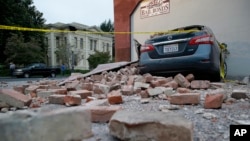A system to provide early warnings of earthquakes such as the one which shook California's wine country this week is planned and ready to go, but two years after the scientific work finished, the funding is still being lined up.
California passed a law last year to start the system, but did not appropriate the money needed to build it.
A system to cover California, Washington and Oregon would cost $38 million, according to the U.S. Geological Survey (USGS).
Had money been available two years ago, the system would likely have been finished by Sunday, when the largest earthquake in the region in 25 years injured more than 200 people and damaged buildings around the city of Napa, said Doug Given, earthquake early warning coordinator for the USGS.
“We don't have the funding to move it forward yet,” he said.
The technology, which can provide a few seconds to halt a speeding train or stop elevators before seismic waves hit, would not have helped residents near the epicenter, where shaking happened too quickly to warn anyone.
Similar systems are already in place in Japan and Mexico. When a magnitude 9.0 earthquake struck eastern Japan on March 11, 2011, people in Sendai, a city of about one million that was the closest big city to the epicenter, had more than 10 seconds to prepare. But those living in the coastal town of Ishinomaki, nearer to the epicenter in the seabed, had only two seconds' warning before tremors began, according to the Japan Meteorological Agency.
Sensors pick up a tremor from shallower and faster-moving waves, known as “P-waves”. A meteorological agency uses that data to estimates the location and intensity of shaking from so-called “S-waves”, which are deeper and cause actual motion on the ground.
A trial version of the U.S. technology, set up in the San Francisco Bay Area and Los Angeles, gave researchers, local governments and state emergency services officials 10 seconds warning before the 6.0 magnitude Napa quake hit, enough time to take basic emergency measures had it been strong enough to threaten San Francisco.
A related system developed by the Berkeley Seismological Laboratory provided a warning to the area's commuter train operator, Bay Area Rapid Transit.
Japanese System
Japan began developing an earthquake warning system after the devastating 1995 Kobe temblor, which caused 6,000 deaths and more than 30,000 injuries, and went online in 2004. When sensors pick up a tremor, the public is warned via television and radio stations, as well as by cellphone alerts and through loudspeaker systems.
In California, the system would piggy-back on an existing network of 400 earthquake monitoring sensors. Scientist envision doubling that to 800 sensors and sending alerts to residents, public utilities and others.
David Oppenheimer, who directs the Northern California Seismic Network for the USGS, said a few seconds would be enough to open a fire station's doors so rescue engines are not trapped inside should a power outage render them inoperable.
USGS scientists have been working on a system for western states for years in cooperation with the California Institute of Technology and the University of California, Berkeley, among others.
A report released by Given's group in May said the $38 million system for California, Washington and Oregon would cost $16 million annually to operate. A California-only system would cost $23 million to build.
But funding from federal and state sources has been slow.
California U.S. Senator Dianne Feinstein on Monday called for federal funding.
“An integrated early warning system is essential to save lives and property,” Feinstein said. “What we need is the political resolve to deploy such a system.”
California state senator Alex Padilla, who represents part of the Los Angeles area hit by the deadly 1994 Northridge earthquake, said scientists complained to him about difficulty obtaining federal funding nearly two years ago.
Governor Jerry Brown signed a law last year directing state emergency services officials to develop a system for California using outside funding, which Padilla said the state was working to identify.
“It wasn't my preference but given what the state has been through for the past decade and the impact on the state' budget, a lot of leaders were wary [of using state funds],” Padilla said.
